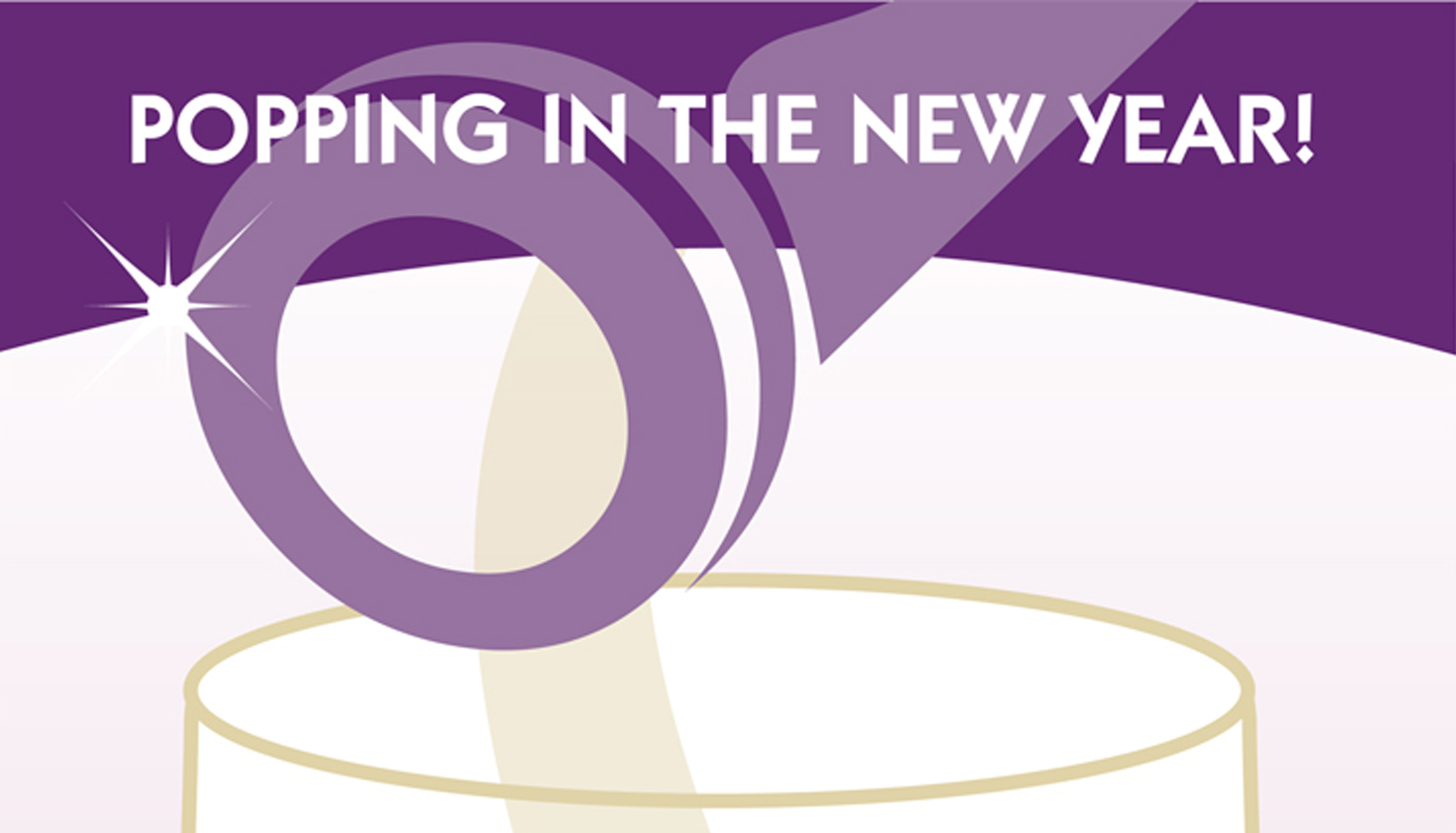NEW YEAR'S DAY
What Americans really want to do on New Year’s Eve

Tradition calls for “ringing” in the new year by painting the town red and sharing a midnight kiss with your true love, but most Americans would rather greet the arrival of 2015 by popping the cork at home with good friends and family. Sixty-one percent of adults polled by Wakefield for the Barefoot Bubby New Year’s Eve survey said they would rather skip the club for a bottle of bubbly at home this New Year’s Eve. Check out how else the majority of Americans plan to watch the ball drop with this infographic.

NEW YEAR'S DAY
Get organized!

By Cynthia Ewer, Author of
Complete Idiot’s Guide to Getting Organized
new year cleaning challenge
Christmas has come and gone … and left a mess behind. Looking around, you wonder how you’ll ever dig out in time for Spring!
Solution? Take the Challenge!
Roar into the New Year and clean house fast with the New Year Cleaning Challenge from OrganizedHome.Com.
Based on Katie Leckey’s Cleaning Grand Plan, the New Year Cleaning Challenge kicks off 2015 with a 14-week plan to clean and organize a spring-clean house.
Working in small weekly bites makes a big job easy, while printable checklists help organize and track cleaning chores. By Spring, you’ll be ready to open the doors to warmer weather.
The 2015 New Year Cleaning Challenge begins on Sunday, January 11, with a Preview Week for lists, questions, and putting the holidays to bed starting on January 4.
Each week, we’ll work through a different area of the home, deep-cleaning and organizing the space for a new, fresh feeling. Along the way, we’ll learn the skills and techniques needed to clean house fast, cut clutter and create an organized and inviting home.
Deep-cleaning the entire house is a big job! To begin, read the complete plan here, or use the week-by-week links below to view each week’s assignment.
Plan and track your progress with printable cleaning checklists from the OrganizedHome.com Printable Library.
Finally, it’s more fun to follow the Cleaning Grand Plan Challenge with a team, so check in for the challenge at our New Year Cleaning Grand Plan Challenge Facebook page. With links to weekly assignments, daily messages and printables, it’s Challenge Central as we work together toward a clean and organized home.
Ready? Set? Let’s clean house for the new year!
NEW YEAR'S DAY
Want to go back to college?

(BPT) – In early January 2014, 21 percent of American workers said they planned to change jobs within the next 12 months, according to a CareerBuilder survey. Introspection is common at the turn of the year, and people who plodded along in less-than-fulfilling jobs for the preceding 11 months begin thinking about what they can do differently in the new year. Many will turn to their education options to help improve their job prospects.
Earning a bachelor’s or master’s degree can help make you more marketable to employers, improve your chances for promotion, and enhance your earning potential.
A degree can also help you change careers. Many working adults turn to competency-based universities, like Western Governors University (WGU), to earn a degree.
Competency-based education lets students focus on what they need to learn and move quickly through what they already know, giving working adults the scheduling flexibility and cost savings they need to balance work and family while mastering the skills required for a degree. At WGU, the average student is 37 years old, and students attend from all 50 states and the District of Columbia.
If you’re thinking about switching careers in 2015, WGU points to four growth areas to consider:
STEM education
Salaries for workers in science, technology, engineering, and math fields rose between 2000 and 2013, and the shortage of STEM professionals continues, US News recently reported. As demand for STEM workers has increased, so has the need for teachers who can prepare students to pursue STEM careers. Institutions like WGU’s Teachers College, which is the nation’s No. 1 producer of STEM teachers, specialize in degree programs that equip graduates to teach math and science at kindergarten through 12th grade levels.
Health care
With more baby boomers reaching retirement age and more Americans covered by health insurance, demand for health care professionals is set to increase significantly over the next 10 years. For career-changers, health care offers many well-paying jobs that require just two- or four-year degrees, and these are growing at a faster rate than other industries.
For example, according to the BLS’ Occupational Outlook Handbook, the industry will need to add more than 64,000 dental hygienists by 2022 in order to keep pace with rising demand. The job requires just a two-year degree and median pay is about $70,000 per year.
Information
technology
Information technology affects nearly every aspect of modern life. The BLS notes that IT professionals are instrumental in keeping systems running, maintaining networks, creating new software, and keeping information systems secure. The industry shed fewer jobs during the recession and is expected to grow far more quickly than other industries, the BLS reports.
Most IT jobs – such as computer network architect or software developer – require a bachelor’s degree in information technology. WGU offers several bachelor’s and master’s degree programs in information technology, most of which include industry certifications as part of the coursework included with tuition.
Business
Demand continues to be strong for managers in all areas of business. Certain business occupations are poised to grow faster than the overall economy.
For example, demand for medical and health services managers will increase 23 percent between now and 2022, the BLS predicts. The profession requires a bachelor’s degree in business administration.
Skilled managers will also find opportunities in IT, human resources, accounting, sales and marketing, and administration.
To learn more about Western Governors University and online bachelor’s and master’s degree programs that can lead to careers in these four growing areas, visit www.wgu.edu.
NEW YEAR'S DAY
Go green in 2015

Goodhousekeeping.com tips offers the following tips on how to go green in 2015.
In the Morning
Brew “certified” coffee. A USDA Certified Organic label means it was grown using sustainable standards.
Green “to go.” Not brewing at home? Take a travel cup to your favorite java joint; they may fill it at a discount.
At Work
Double up. Configure your office printer or copy machine so it prints on both sides of the page.
Put it to sleep. If you’ll be away from your computer for more than 20 minutes, change it to “sleep” mode.
Running Errands
BYOB. Bags, that is. It’s good for your wallet, too: Some retailers, such as CVS, now pay you for every disposable bag you don’t take ($1 on a special CVS card for every four trips on which you BYO).
Before Bed
Truly turn off electronics. Plug your devices — the TV and DVD player, or the computer and printer — into a UL-certified power strip; switch the whole group off for the evening to prevent phantom electrical draw.
Start ‘Em Young
Game off? Yep, get the kids to turn off video games (both the TV and the console) after they’re done playing, and you’ll win back about $100 per year.
Don’t tap out. Teach children to turn off the water while brushing their teeth. Leaving the tap running during the recommended two minutes of brushing can waste up to five gallons of water a day.
Green My Ride
In January 1994, GH lamented that American cars were only required to average 27.5 miles per gallon, noting, “If the U.S. required American automakers to produce cars averaging 45 miles per gallon of gas (the Honda Civic VX already averages 55 mpg)… the country would save 3.1 million barrels of oil a day.” So how are we doing? U.S. cars are required to average 35.5 miles per gallon — by 2016. In the meantime, use these three tricks to up your mpg.
Slow down. Driving 10 mph above 60 is like adding nearly 50 cents to the price of a gallon of gas, since higher speed equals more guzzling.
Get pumped. Once a month, check the pressure of each of the tires against the guidelines listed in your car’s manual; add air if needed. Doing this can improve mileage by about 3 percent.
Air out. Replace filters regularly. A new oxygen sensor alone can improve mileage by as much as 15 percent.
-

 NEWS3 years ago
NEWS3 years ago2 hurt, 1 jailed after shooting incident north of Nocona
-

 NEWS2 years ago
NEWS2 years agoSuspect indicted, jailed in Tia Hutson murder
-

 NEWS2 years ago
NEWS2 years agoSO investigating possible murder/suicide
-

 NEWS2 years ago
NEWS2 years agoWreck takes the life of BHS teen, 16
-

 NEWS2 years ago
NEWS2 years agoMurder unsolved – 1 year later Tia Hutson’s family angry, frustrated with no arrest
-

 NEWS2 years ago
NEWS2 years agoSheriff’s office called out to infant’s death
-

 NEWS2 years ago
NEWS2 years agoBowie Police face three-hour standoff after possible domestic fight
-

 NEWS3 years ago
NEWS3 years agoDriver stopped by a man running into the street, robbed at knifepoint






